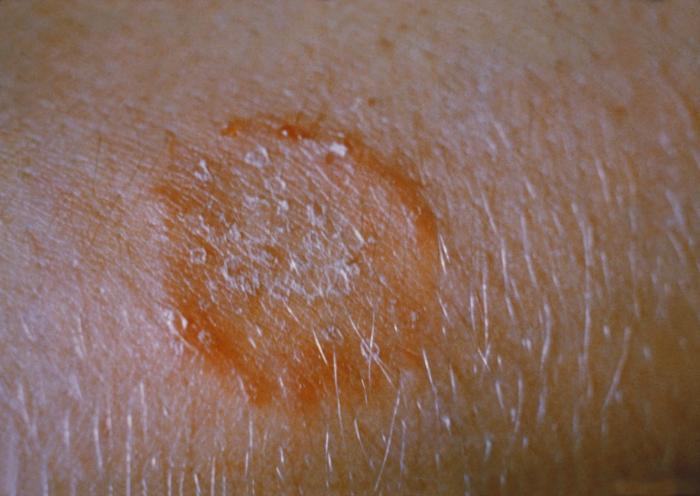Tinea corporis
Editor-In-Chief: Prab R Tumpati, MD
Obesity, Sleep & Internal medicine
Founder, WikiMD Wellnesspedia &
W8MD medical weight loss NYC and sleep center NYC
| Tinea corporis | |
|---|---|

| |
| Synonyms | Ringworm of the body |
| Pronounce | N/A |
| Specialty | N/A |
| Symptoms | Rash, itching, redness, scaling |
| Complications | Secondary bacterial infection |
| Onset | Any age |
| Duration | Weeks to months |
| Types | N/A |
| Causes | Fungal infection by dermatophytes |
| Risks | Warm and humid climates, close contact, immunocompromised |
| Diagnosis | Clinical examination, KOH test, fungal culture |
| Differential diagnosis | Psoriasis, eczema, pityriasis rosea |
| Prevention | Good hygiene, avoid sharing personal items |
| Treatment | Topical antifungals, oral antifungals |
| Medication | Clotrimazole, terbinafine, fluconazole |
| Prognosis | N/A |
| Frequency | Common |
| Deaths | N/A |
Tinea Corporis, commonly referred to as ringworm, is a dermatophyte infection of the superficial layer of the skin. Not to be mistaken as a parasitic infestation, Tinea Corporis derives its name from the characteristic ring-like appearance it forms on the skin.
Classification[edit | edit source]
The condition falls under a broader umbrella of cutaneous fungal infections, which also include conditions such as tinea pedis (athlete's foot), tinea capitis (scalp ringworm), and tinea cruris (jock itch). These are all caused by various species of the genera Trichophyton, Microsporum, and Epidermophyton.
Pathophysiology[edit | edit source]
- Dermatophytes are fungi that live on keratin, a protein found in the skin, hair, and nails. When the environment is suitable, these fungi can multiply and invade the skin, resulting in Tinea Corporis.
- The fungi penetrate the stratum corneum, the outermost layer of the skin, using enzymes like keratinases. In response to the fungal invasion, the body's immune system reacts, causing symptoms such as inflammation, itching, and redness.
Clinical Presentation[edit | edit source]
The characteristic manifestation of Tinea Corporis is a red, itchy, circular rash with a clear center, often referred to as a "ring" because of its appearance. The border of the lesion may be scaly or raised. The infection can occur anywhere on the body.
Diagnosis[edit | edit source]
Diagnosis of Tinea Corporis typically involves a physical examination by a healthcare professional. The clinician may employ dermoscopy or perform a potassium hydroxide (KOH) preparation of skin scrapings for microscopic examination. In some cases, fungal culture may be used to identify the specific organism causing the infection.
Treatment[edit | edit source]
The primary mode of treatment for Tinea Corporis is the application of topical antifungal medications, such as terbinafine, clotrimazole, or miconazole. In severe or resistant cases, systemic antifungals, such as itraconazole or fluconazole, may be prescribed.
Prevention[edit | edit source]
Preventive measures for Tinea Corporis include maintaining proper personal hygiene, avoiding sharing personal items like towels or clothing, and avoiding contact with infected individuals or animals.
See Also[edit | edit source]
References[edit | edit source]
- Elewski, B.E. (1996). "Onychomycosis: Pathogenesis, Diagnosis, and Management". Clinical Microbiology Reviews. 9 (3): 415–429.
- Ghannoum, Mahmoud A.; Rice, Louis B. (1999). "Antifungal Agents: Mode of Action, Mechanisms of Resistance, and Correlation of These Mechanisms with Bacterial Resistance". Clinical Microbiology Reviews. 12 (4): 501–517.
- Hay, Roderick J. (2010). "Tinea Corporis". In Goldsmith, Lowell A. (ed.). Fitzpatrick's Dermatology in General Medicine (8th ed.). McGraw Hill. pp. 2234–2235.
External links[edit | edit source]
Ringworm (Tinea Corporis) - American Academy of Dermatology Tinea corporis - MedlinePlus Tinea corporis - DermNet NZ
Search WikiMD
Ad.Tired of being Overweight? Try W8MD's physician weight loss program.
Semaglutide (Ozempic / Wegovy and Tirzepatide (Mounjaro / Zepbound) available.
Advertise on WikiMD
|
WikiMD's Wellness Encyclopedia |
| Let Food Be Thy Medicine Medicine Thy Food - Hippocrates |
Translate this page: - East Asian
中文,
日本,
한국어,
South Asian
हिन्दी,
தமிழ்,
తెలుగు,
Urdu,
ಕನ್ನಡ,
Southeast Asian
Indonesian,
Vietnamese,
Thai,
မြန်မာဘာသာ,
বাংলা
European
español,
Deutsch,
français,
Greek,
português do Brasil,
polski,
română,
русский,
Nederlands,
norsk,
svenska,
suomi,
Italian
Middle Eastern & African
عربى,
Turkish,
Persian,
Hebrew,
Afrikaans,
isiZulu,
Kiswahili,
Other
Bulgarian,
Hungarian,
Czech,
Swedish,
മലയാളം,
मराठी,
ਪੰਜਾਬੀ,
ગુજરાતી,
Portuguese,
Ukrainian
Medical Disclaimer: WikiMD is not a substitute for professional medical advice. The information on WikiMD is provided as an information resource only, may be incorrect, outdated or misleading, and is not to be used or relied on for any diagnostic or treatment purposes. Please consult your health care provider before making any healthcare decisions or for guidance about a specific medical condition. WikiMD expressly disclaims responsibility, and shall have no liability, for any damages, loss, injury, or liability whatsoever suffered as a result of your reliance on the information contained in this site. By visiting this site you agree to the foregoing terms and conditions, which may from time to time be changed or supplemented by WikiMD. If you do not agree to the foregoing terms and conditions, you should not enter or use this site. See full disclaimer.
Credits:Most images are courtesy of Wikimedia commons, and templates, categories Wikipedia, licensed under CC BY SA or similar.
Contributors: Prab R. Tumpati, MD


